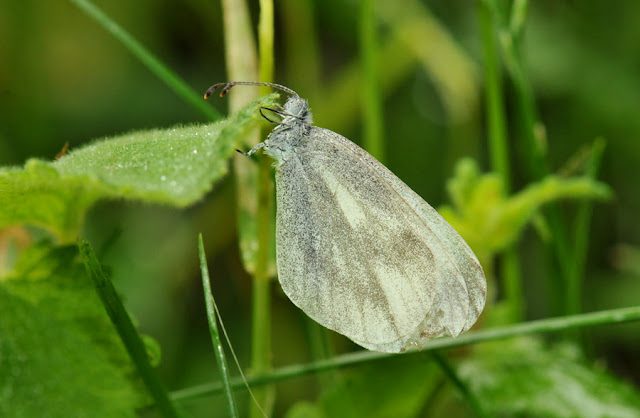Whilst Saturday did not look the best of days to go butterflying, we decided to take a chance with the weather and venture out of county! Our first stop of the day was to Branscombe in Devon and for a walk along the cliffs to look for Wood White. It was raining when we arrived but we could see some breaks in the cloud so when the rain stopped we started our walk! Something tells you that when you have to put your raincoat on to go for a walk you are probably not likely to see any butterflies!
It was a lovely walk along the coast path and we soon found ourselves in the woodland growing below the cliffs next to the beach. The sea was crashing in and there was a view of the coast towards Sidmouth.
Returning to the car, something white caught John's eye and he discovered a Wood White roosting in the grass right next to the coast path! This delicate little butterfly is quite unusual in its appearance, its antennae are bent over at the end and when at rest its body is completely hidden by its wings.
John then found another Wood White on the other side of the path hiding underneath a leaf in the grass. The photograph below shows the second butterfly.
Our next visit was to Cerne Abbas, with a stop at the Cerne Giant viewpoint! We had a walk along the hillside but it was quite windy and any butterflies we saw flew quickly by! We found several species, Marsh Fritillary, Grizzled and Dingy Skipper, Common Blue, Small Heath and Brown Argus.
Our final destination of the day was Martin Down Nature Reserve. On went the raincoat again as we walked across the reserve! We met a group of people coming back from a walk and they told us that they had just been looking at the Burnt Tip Orchids. They kindly told us where to find them, and we counted 19 flower spikes of this lovely orchid.
Our last butterfly of the day was this male Adonis Blue. He spent most of his time with his wings shut, but briefly showed his beautiful bright blue wings when the sun shone through a break in the clouds.
And finally, I photography this growing thistle flower as I liked the symmetry of the flower head.






















































